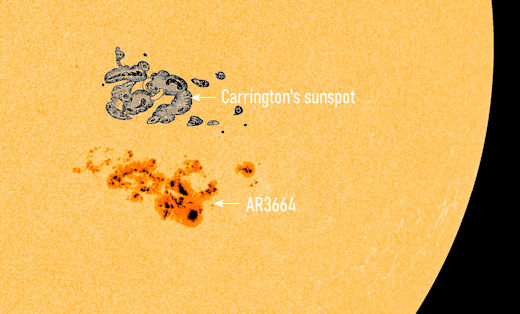|
|
Post by blacktothefuture on May 10, 2024 13:29:58 GMT
|
|
|
|
Post by abbey1227 on May 10, 2024 13:43:38 GMT
Just more definitive proof of .....................climate change. ![[raspberry]](http://storage.proboards.com/6870873/images/URfbnorGJoHZMsqWxsFb.gif) |
|
|
|
Post by hugsfromlv426 on May 10, 2024 14:00:46 GMT
News reports are starting to come in. It looks serious. |
|
|
|
Post by Winter_King on May 10, 2024 16:00:42 GMT
|
|
|
|
Post by thekindercarebear on May 10, 2024 16:03:15 GMT
i'm still going with space vampires. =/
|
|
|
|
Post by abbey1227 on May 10, 2024 16:08:26 GMT
i'm still going with space vampires. =/
If she looks like the movie............. I'm down wit dat ![[grin]](http://storage.proboards.com/6870873/images/CBubFSUbXfyoLMZUjeBb.gif) |
|
|
|
Post by Mulder and Scully on May 10, 2024 16:10:20 GMT
Just more definitive proof of .....................climate change. ![[raspberry]](http://storage.proboards.com/6870873/images/URfbnorGJoHZMsqWxsFb.gif) Climate change has nothing to do with solar flares lol. |
|
|
|
Post by abbey1227 on May 10, 2024 16:14:11 GMT
Just more definitive proof of .....................climate change. ![[raspberry]](http://storage.proboards.com/6870873/images/URfbnorGJoHZMsqWxsFb.gif) Climate change has nothing to do with solar flares lol.
shhhh shhhhhh shush now
Some celebrity told me that a few weeks ago. ............on the View, perhaps?
|
|
|
|
Post by PaulsLaugh on May 10, 2024 16:21:55 GMT
Just more definitive proof of .....................climate change. ![[raspberry]](http://storage.proboards.com/6870873/images/URfbnorGJoHZMsqWxsFb.gif) Proof of climate change is the fact that our climate is indeed changing. The explosive expansion of the global population and technological progress has greatly influenced agriculture and food production. However, this progress is threatened by climate change, which unleashes a slew of issues like carbon dioxide (CO2) increases, frequent droughts, and temperature shifts that present a substantial obstacle to crop yields and food security. The ramifications of these climatic factors on insect pest biology and ecology are profound, given that these pests depend heavily on these factors. Since crop productivity is tightly connected to both insect pests and these climate variables, changes in these factors can significantly impact crop yields. Therefore, it is imperative to comprehend the impact of climate change on insect pests to manage them effectively and ensure sufficient food production. This review examines the climate change effect on insect pest biology and ecology and explores the potential use of modern pest monitoring technologies and prediction tools to devise effective pest management strategies to improve crop production and food security. www.sciencedirect.com/science/article/pii/S2666154323002405 |
|
|
|
Post by PaulsLaugh on May 10, 2024 16:24:57 GMT
Climate change has nothing to do with solar flares lol.
shhhh shhhhhh shush now
Some celebrity told me that a few weeks ago. ............on the View, perhaps?
See there is your problem, you listen to TV celebrities like Donald Trump thinking they know some stuff. |
|
|
|
Post by hugsfromlv426 on May 10, 2024 16:31:02 GMT
i'm still going with space vampires. =/
If she looks like the movie............. I'm down wit dat ![[grin]](http://storage.proboards.com/6870873/images/CBubFSUbXfyoLMZUjeBb.gif) Mathilda May? I'll take two please! |
|
|
|
Post by TheGoodMan19 on May 10, 2024 16:43:51 GMT
Thanks, Biden
|
|
|
|
Post by cat on May 10, 2024 16:51:02 GMT
Um, yikes!
|
|
|
|
Post by Orlando City Cat on May 10, 2024 17:35:19 GMT
The sun has a Carrington Class sunspot complex. A CARRINGTON-CLASS SUNSPOT: Sunspot AR3664 has grown so large, it now rivals the great Carrington sunspot of 1859. To illustrate their similarity, we've added Carrington's famous sketch (to scale) to a NASA photo of today's sun: Sprawling almost 200,000 km from end to end, AR3664 is 15 times wider than Earth. You can see it through ordinary eclipse glasses with no magnification at all. Moreover, it is easy to project an image of this sunspot onto the sidewalk or a white screen just as Carrington did in the 19th century. Carrington's sunspot is famous because in August and Sept. 1859 it emitted a series of intense solar flares and CMEs. The resulting geomagnetic storms set fire to telegraph offices and sparked auroras from Cuba to Hawaii. The "Carrington Event" has since become a touchstone of space weather in pop culture, with recent headlines stoking fears of an "internet apocalypse" if it repeats. Indeed, it could repeat. Studies suggest that Carrington-class storms occur once every 40 to 60 years, so we're overdue. CMEs currently en route to Earth will not cause a new Carrington Event; they are puny compared to the CMEs of 1859. Nevertheless, it would be wise to keep an eye on this growing active region while Earth is in its strike zone. CME impact alerts: SMS Text more images: from Martin Wise of Trenton, Florida  |
|
|
|
Post by Orlando City Cat on May 10, 2024 17:38:57 GMT
|
|